
How to Use TDS Sensor: Examples, Pinouts, and Specs
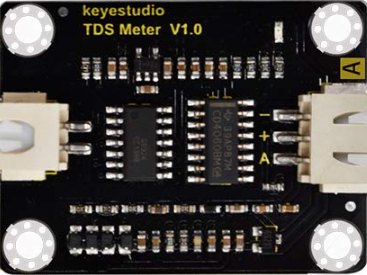
 Design with TDS Sensor in Cirkit Designer
Design with TDS Sensor in Cirkit DesignerIntroduction
The TDS (Total Dissolved Solids) Sensor, manufactured by Seeed, is a device designed to measure the concentration of dissolved solids in a liquid, typically water. It operates by detecting the electrical conductivity of the solution, which correlates to the amount of dissolved ions present. This sensor is widely used in water quality monitoring, aquariums, hydroponics, and water treatment systems to ensure the safety and quality of water.
Explore Projects Built with TDS Sensor
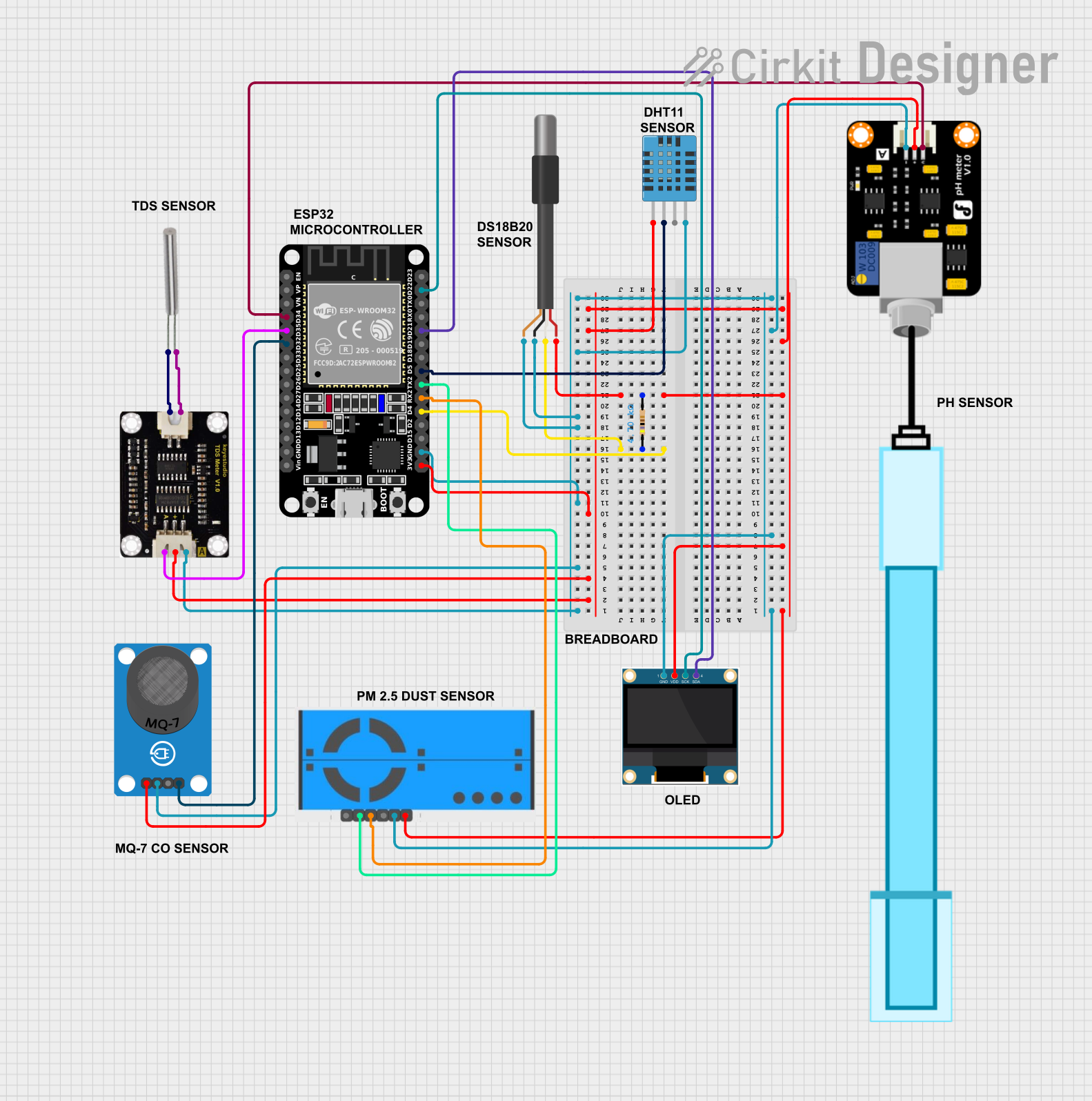
 Open Project in Cirkit Designer
Open Project in Cirkit Designer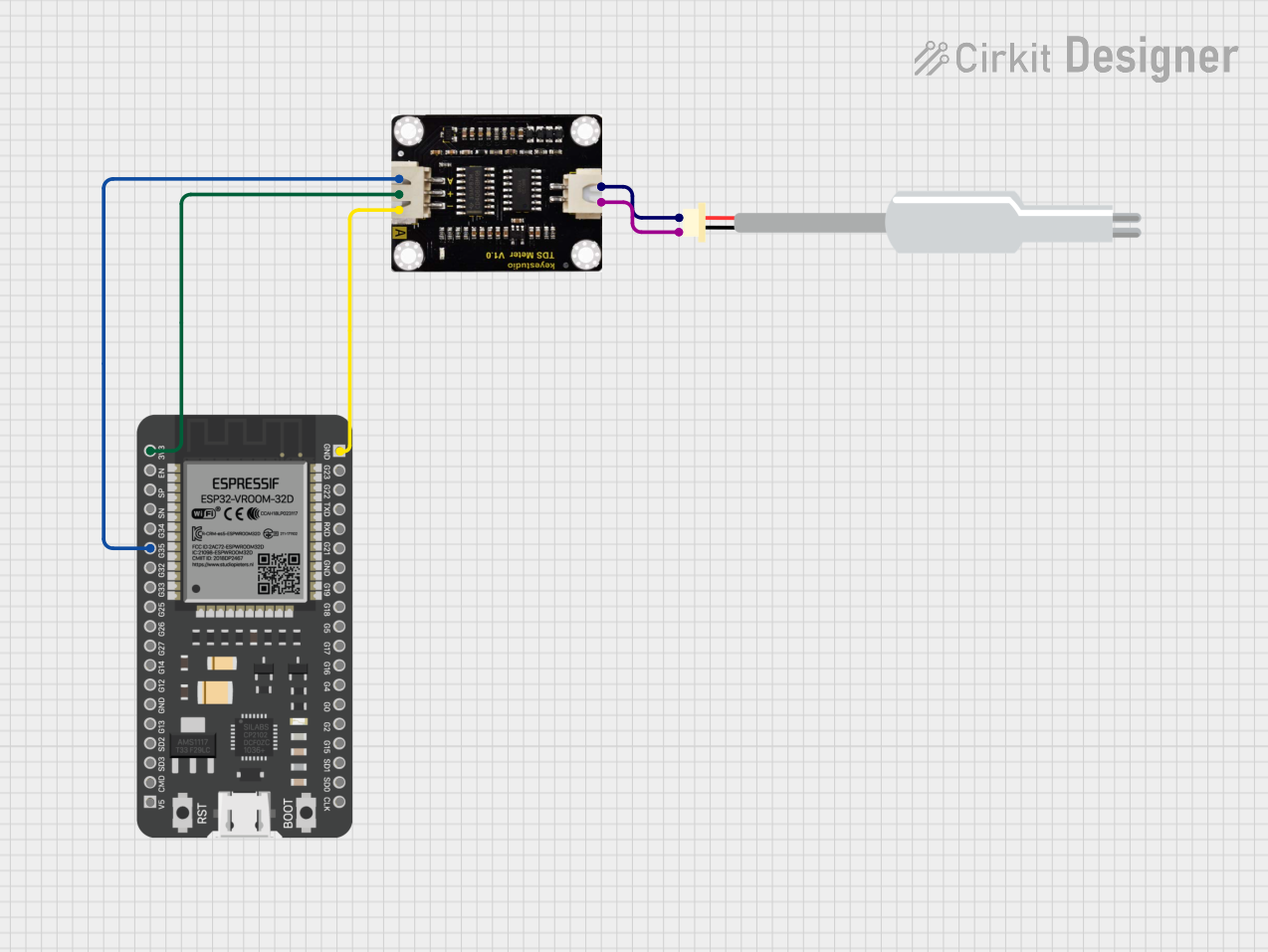
 Open Project in Cirkit Designer
Open Project in Cirkit Designer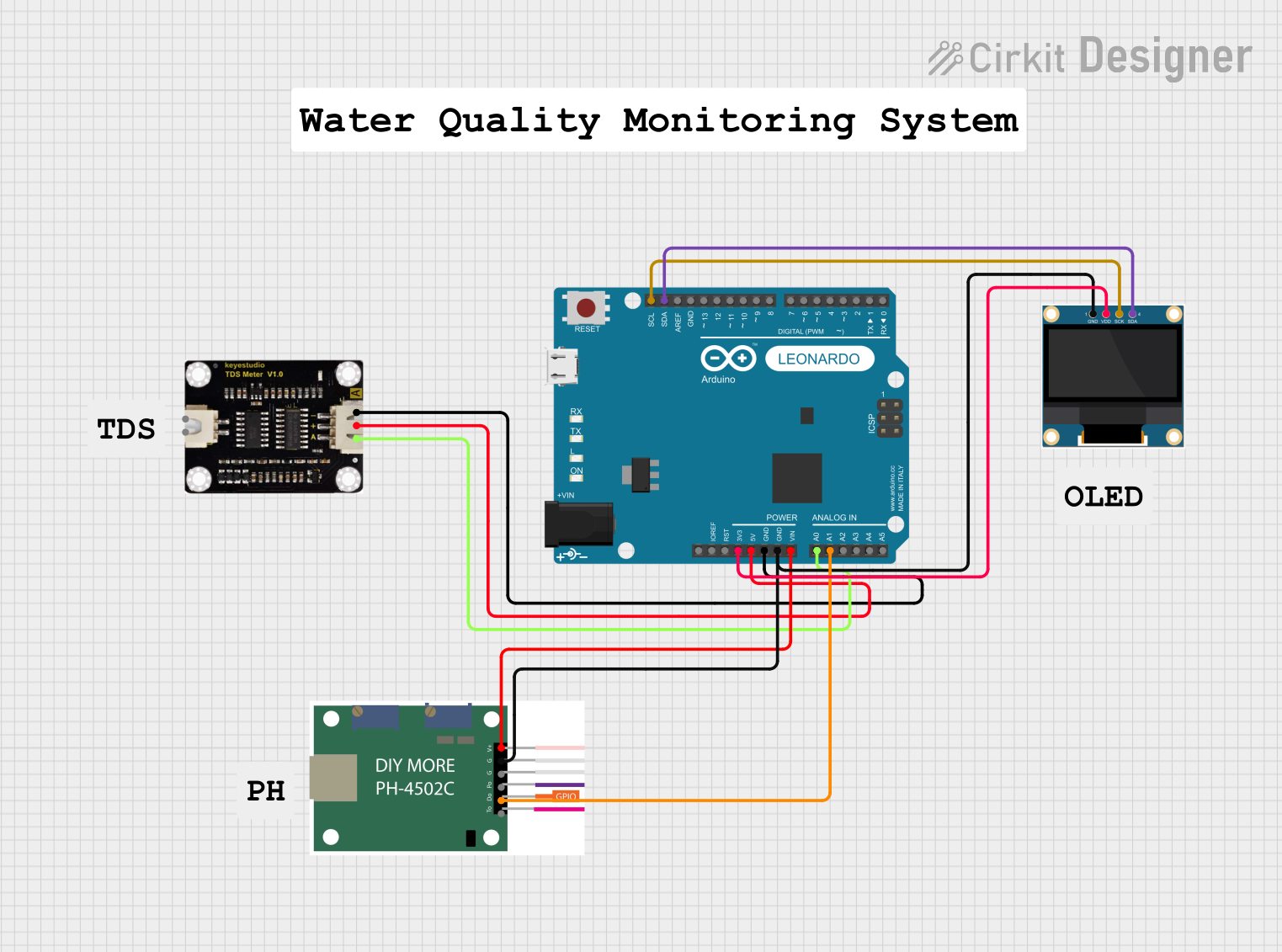
 Open Project in Cirkit Designer
Open Project in Cirkit Designer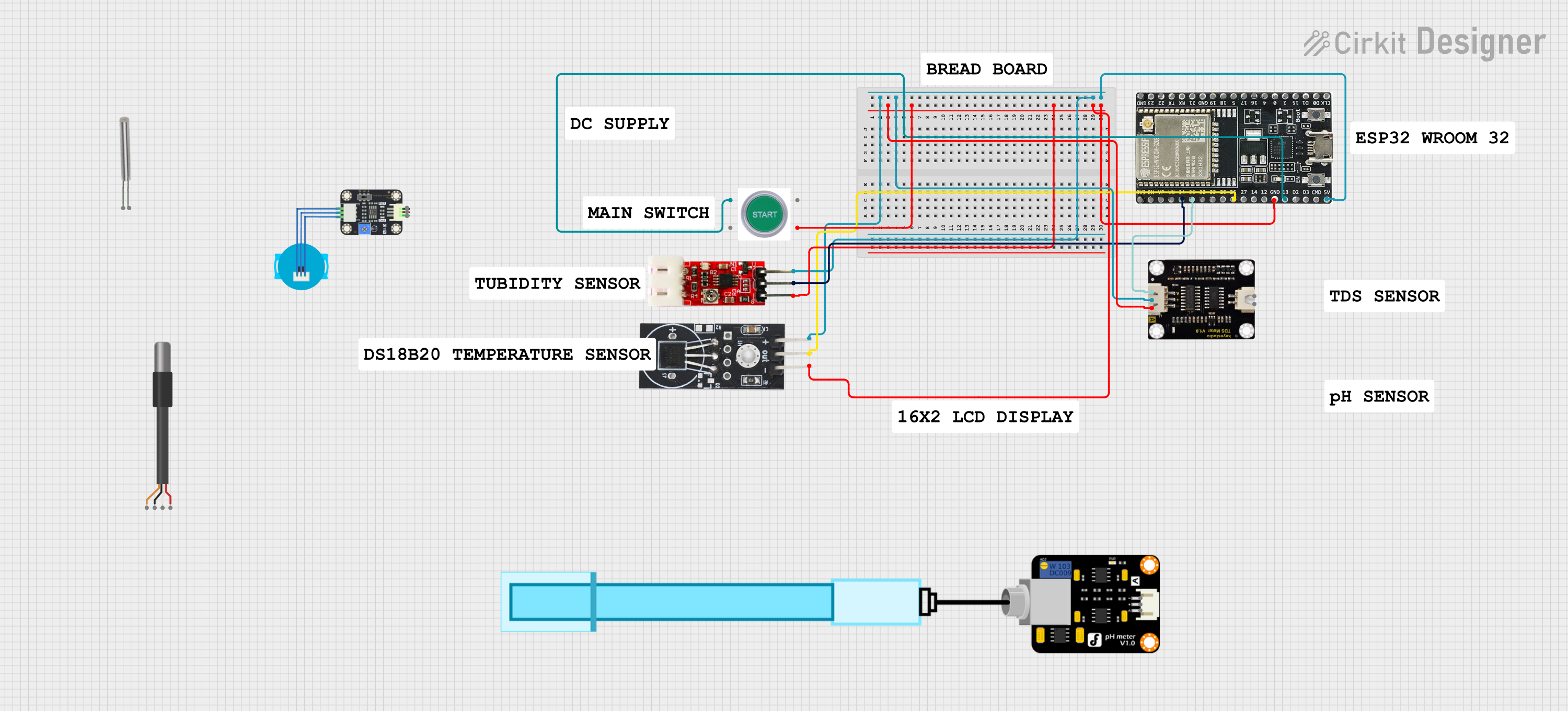
 Open Project in Cirkit Designer
Open Project in Cirkit DesignerExplore Projects Built with TDS Sensor

 Open Project in Cirkit Designer
Open Project in Cirkit Designer
 Open Project in Cirkit Designer
Open Project in Cirkit Designer
 Open Project in Cirkit Designer
Open Project in Cirkit Designer
 Open Project in Cirkit Designer
Open Project in Cirkit DesignerCommon Applications and Use Cases
- Monitoring water quality in aquariums and hydroponic systems
- Testing drinking water for impurities
- Industrial water treatment and filtration systems
- Environmental water quality assessments
- Educational and research purposes in chemistry and environmental science
Technical Specifications
The TDS Sensor from Seeed is designed for ease of use and compatibility with microcontrollers like Arduino. Below are its key technical details:
Key Technical Details
| Parameter | Value |
|---|---|
| Operating Voltage | 3.3V - 5.5V |
| Output Signal | Analog (0 - 2.3V) |
| Measurement Range | 0 - 1000 ppm (parts per million) |
| Accuracy | ±10% of the measured value |
| Temperature Compensation | Yes (via external temperature sensor) |
| Probe Material | Stainless steel |
| Cable Length | 1 meter |
| Operating Temperature | 0°C - 40°C |
Pin Configuration and Descriptions
The TDS Sensor module has a simple pinout for easy integration with microcontrollers. Below is the pin configuration:
| Pin Name | Description |
|---|---|
| VCC | Power supply input (3.3V - 5.5V) |
| GND | Ground connection |
| AOUT | Analog output signal proportional to TDS value |
Usage Instructions
How to Use the TDS Sensor in a Circuit
Connect the Sensor to a Microcontroller:
- Connect the
VCCpin to the 5V (or 3.3V) power supply of your microcontroller. - Connect the
GNDpin to the ground of your microcontroller. - Connect the
AOUTpin to an analog input pin on your microcontroller (e.g., A0 on an Arduino UNO).
- Connect the
Calibrate the Sensor:
- Use a standard solution with a known TDS value (e.g., 342 ppm) to calibrate the sensor.
- Adjust the potentiometer on the module to match the expected TDS value.
Write Code to Read the Sensor Data:
- Use the analog input of your microcontroller to read the sensor's output voltage.
- Convert the voltage to a TDS value using the formula provided in the sensor's datasheet.
Temperature Compensation:
- If the water temperature varies significantly, use an external temperature sensor to apply compensation for more accurate readings.
Important Considerations and Best Practices
- Avoid Corrosion: Clean the stainless steel probe regularly to prevent corrosion and ensure accurate readings.
- Immersion Depth: Ensure the probe is fully submerged in the liquid but avoid immersing the entire module.
- Avoid Air Bubbles: Ensure no air bubbles are trapped around the probe, as this can affect the readings.
- Power Supply Stability: Use a stable power supply to avoid fluctuations in the sensor's output.
Example Code for Arduino UNO
Below is an example code snippet to interface the TDS Sensor with an Arduino UNO:
// Define the analog pin connected to the TDS sensor
const int TDS_PIN = A0;
// Define the voltage reference of the Arduino (5V or 3.3V)
const float VREF = 5.0;
// Define the TDS factor (calibration constant, typically 0.5)
const float TDS_FACTOR = 0.5;
void setup() {
Serial.begin(9600); // Initialize serial communication
pinMode(TDS_PIN, INPUT); // Set the TDS pin as input
}
void loop() {
// Read the analog value from the TDS sensor
int analogValue = analogRead(TDS_PIN);
// Convert the analog value to voltage
float voltage = analogValue * (VREF / 1024.0);
// Calculate the TDS value in ppm
float tdsValue = (voltage / TDS_FACTOR) * 1000;
// Print the TDS value to the Serial Monitor
Serial.print("TDS Value: ");
Serial.print(tdsValue);
Serial.println(" ppm");
delay(1000); // Wait for 1 second before the next reading
}
Troubleshooting and FAQs
Common Issues and Solutions
Inaccurate Readings:
- Cause: The sensor is not calibrated.
- Solution: Calibrate the sensor using a standard solution with a known TDS value.
Fluctuating Output:
- Cause: Unstable power supply or electrical noise.
- Solution: Use a stable power source and ensure proper grounding.
No Output Signal:
- Cause: Incorrect wiring or damaged sensor.
- Solution: Verify the connections and check the sensor for physical damage.
Corrosion on the Probe:
- Cause: Prolonged exposure to water without cleaning.
- Solution: Clean the probe with distilled water and a soft cloth.
FAQs
Q: Can the TDS Sensor measure salinity?
A: While the TDS Sensor is not specifically designed for salinity measurement, it can provide an approximate value since salinity contributes to the total dissolved solids in water.
Q: Is the sensor waterproof?
A: The probe is waterproof, but the module itself is not. Ensure only the probe is submerged in water.
Q: How often should I calibrate the sensor?
A: Calibration frequency depends on usage, but it is recommended to calibrate the sensor monthly or whenever accuracy is critical.
Q: Can I use the TDS Sensor with a 3.3V microcontroller?
A: Yes, the sensor is compatible with both 3.3V and 5V microcontrollers.